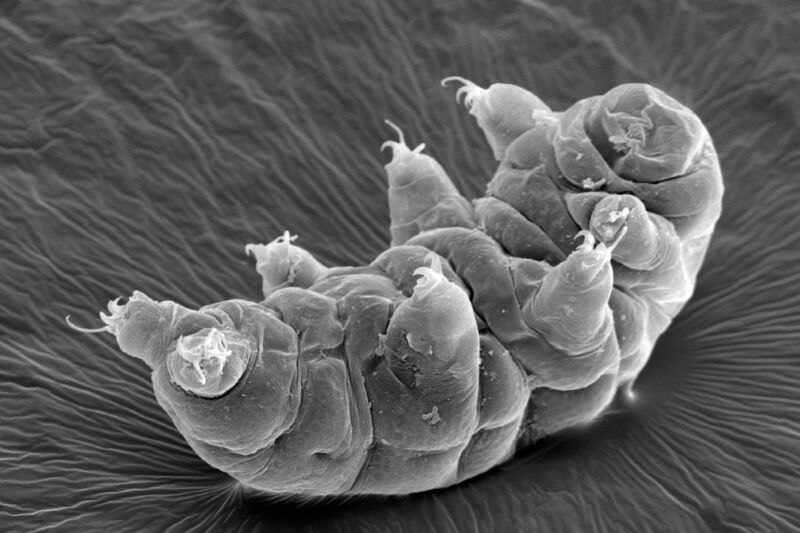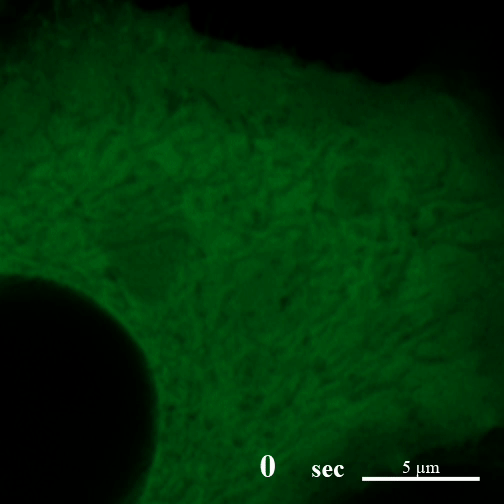
Tardigrades are micro-animals that can survive in the harshest conditions: extreme pressure, extreme temperature, radiation, dehydration, starvation—even exposure to the vacuum of outer space. Scientists at the University of Tokyo have now identified the mechanism to explain how tardigrades can survive extreme dehydration in particular, according to a new paper published in the journal PLoS Biology—a protein that forms a protective gel-like network to protect dried-out cells.
As we've reported previously, the creatures were first described by German zoologist Johann Goeze in 1773. They were dubbed tardigrada ("slow steppers" or "slow walkers") four years later by Lazzaro Spallanzani, an Italian biologist. That's because tardigrades tend to lumber along like a bear. Since they can survive almost anywhere, they can be found in lots of places: deep-sea trenches, salt and freshwater sediments, tropical rain forests, the Antarctic, mud volcanoes, sand dunes, beaches, and lichen and moss. (Another name for them is "moss piglets.")
When their moist habitat dries up, however, tardigrades go into a state known as "tun"—a kind of suspended animation, which the animals can remain in for as long as 10 years. When water begins to flow again, water bears absorb it to rehydrate and return to life. They're not technically members of the extremophile class of organisms since they don't so much thrive in extreme conditions as endure; technically, they belong to the class of extremotolerant organisms. But their hardiness makes tardigrades a favorite research subject for scientists.
For instance, one 2020 study found that the water bear's distinctive gait resembles that of insects 500,000 times their size, despite a 20 million-year evolutionary gap between them. And in 2019, an Israeli spacecraft carrying the tiny creatures in a tun state crash-landed on the Moon, leading to speculation that the tardigrades might have survived the impact.

Alas, it is highly unlikely the plucky tardigrades survived, per a study published last year by British scientists. They put several tardigrades into a tun state and placed two to four at a time in a hollow nylon bullet. Next, the scientists fired the tardigrades at a sand target at increasing speeds using a two-stage light gas gun. The result: The water bears could survive impacts up to about 900 meters per second (3,000 kilometers per hour) and momentary shock pressures up to 1.14 gigapascals (GPa). (Beyond that, they just turn to mush.) The lander may have crashed at a few hundred meters per second, but the shock of its metal frame hitting the surface would have generated pressures "well above" 1.14 GPa, the researchers told Science.
Most relevant to this latest study is a 2017 paper demonstrating that tardigrades use a special kind of disordered protein to literally suspend their cells in a glasslike matrix that prevents damage. The researchers dubbed this a "tardigrade-specific intrinsically disordered protein" (TDP). In other words, the cells become vitrified. The more TDP genes a tardigrade species has, the more quickly and efficiently it goes into the tun state. As University of North Carolina, Chapel Hill, biologist Thomas Boothby told Ars at the time:
What we think is happening is basically that, as the tardigrades are drying out, they are making a lot of these disordered proteins. These proteins essentially fill the cytoplasm of the tardigrade cells and, as they dry, form a glassy matrix within the cell. All the desiccation-sensitive stuff (proteins, nucleic acids, membranes) in the tardigrade cells get trapped in the pores of this matrix, essentially encapsulated in a protective glass-like coating. This encapsulation prevents the unfolding, rupture, breakage, and/or aggregation of desiccation-sensitive biological material. Once water is added back to the system, the disordered proteins that make up this glassy matrix melt back into solution, leaving behind all the protected parts of the cell.
However, last year another team of Japanese scientists called this "vitrification" hypothesis into question, citing experimental data suggesting that the 2017 findings could be attributed to water retention of the proteins. This latest study supports that counter-hypothesis. "Our data suggest a novel desiccation tolerance mechanism based on filament/gel formation," the authors of the new study wrote.
“Although water is essential to all life we know of, some tardigrades can live without it potentially for decades. The trick is in how their cells deal with this stress during the process of dehydration,” said co-author Takekazu Kunieda of the University of Tokyo. “It’s thought that as water leaves a cell, some kind of protein must help the cell maintain physical strength to avoid collapsing in on itself. After testing several different kinds, we have found that cytoplasmic-abundant heat soluble (CAHS) proteins, unique to tardigrades, are responsible for protecting their cells against dehydration.”
In this scenario, the CAHS proteins kick into action when they sense that their encapsulating cell has become dehydrated, forming gel-like filaments (as opposed to a glassy matrix) as they dry out. Those filaments, in turn, form networks that maintain the structural shape of the cell without its water. When the tardigrade rehydrates, the filaments gradually recede, ensuring that the cell isn't stressed or damaged as it regains water.

Kunieda and colleagues also spliced the protein genes into insect and human cultured cells. This was initially challenging since the cells had to be stained to be visible under the microscope. Most staining methods call for water-based solutions, and water concentration was a key variable that needed to be controlled for this study. They solved the problem by incorporating the stain into a methanol-based solution. The result: The CAHS proteins exhibited the same behavior in insect cells and even showed limited functionality in the human cells, suggesting that this feature might not be confined to tardigrade cells.
Among other potential applications, the findings could one day lead to new methods for preserving biological materials over long periods, which is useful to extend the shelf-life of certain medicines or vaccines, or even whole organs awaiting transplant.
DOI: PLoS Biology, 2022. 10.1371/journal.pbio.3001780 (About DOIs).


3175x175(CURRENT).thumb.jpg.b05acc060982b36f5891ba728e6d953c.jpg)

Recommended Comments
There are no comments to display.
Join the conversation
You can post now and register later. If you have an account, sign in now to post with your account.
Note: Your post will require moderator approval before it will be visible.